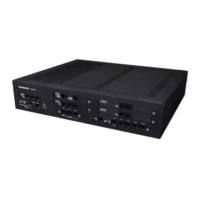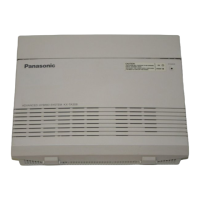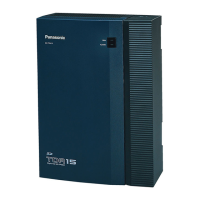[Programming Example]
Caller
Called Party
COS 1 COS 2 COS 3 COS 4 COS 5 COS 6 ...
COS 1 ...
COS 2 ...
COS 3
ü ü
...
COS 4
ü ü
...
COS 5
ü ü ü ü
...
COS 6
ü ü ü ü
...
: : : : : : : :
ü: Block
Explanation:
1. Assign each extension in a tenant to a certain COS number. Each tenant must have unique COS
numbers.
Tenant 1: COS 1 and COS 2
Tenant 2: COS 3 and COS 4
Tenant 3: COS 5 and COS 6
2. Tenant-to-Tenant Call Block enables by the Internal Call Block feature.
a. Tenant
1
(COS 1 and COS 2) can make calls to both Tenant 2 (COS 3 and COS 4) and Tenant 3
(COS 5 and COS 6) as well as Tenant 1.
b. Tenant 2 (COS 3 and COS 4) can make calls to Tenant 1 (COS 1 and COS 2) and Tenant 2.
c. Tenant 3 (COS 5 and COS 6) can make calls to Tenant 3 itself only.
• An incoming call distribution group must belong to one tenant because the following features are
determined on a tenant basis (® 1.2.2.1 Incoming Call Distribution Group Features—SUMMARY):
– Music on Hold while a call is waiting in the queue
– The Time Table which determines the overflow destination
PC Programming Manual References
4.4 [2-2] Operator & BGM
→
PBX Operator—Day, Lunch, Break, Night
→ BGM and Music on Hold—Music on Hold
4.6 [2-4] Week Table
4.8 [2-5] Holiday Table
4.14 [2-7-3] Class of Service—Internal Call Block
5.7 [3-2] User Group
5.13 [3-5-1] Incoming Call Distribution Group—Group Settings—Main— Tenant Number
6.1 [4-1-1] Wired Extension—Extension Settings—Main— User Group
6.10 [4-2-1] Portable Station—Extension Settings—Main— User Group
7.1 [5-1] Doorphone— Tenant Number
7.7 [5-5] External Sensor— Tenant No.
8.1 [6-1] System Speed Dial
8.6 [6-6] Tenant
Section 10 [8] ARS
10.6 [8-5] Carrier—Authorisation Code for Tenant
406 Feature Guide
2.2.3 Tenant Service

